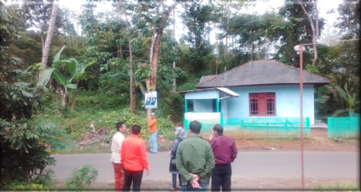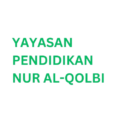KALIBUNDER
DEVELOPMENT PROGRAM OF NUR AL-QOLBI
FOUNDATION CIRACAP

This vacant land is still empty but already holds many opportunities, starting from environmental development and developing into various benefits for the community:
1. Education and Teaching
- Establishing Schools or Islamic Boarding Schools (Pesantren): The vacant land can be used to establish educational institutions such as primary, secondary schools, or pesantren (Islamic boarding schools). This would provide better access to education for children in the Ciracap area and contribute to the development of human resources.
- Skill Classes and Training: The land can be used to build training spaces for the local community, offering courses in skills development, technology, or entrepreneurship.
2. Agriculture and Food Security
- Educational Gardens: The vacant land can be transformed into a garden for teaching the local community, especially children and youth, about organic farming, food crops, or herbal plant cultivation.
- Food Security Programs: By utilizing part of the land for farming or gardening, the foundation can help create food security for itself and the surrounding community, especially during uncertain economic times.
3. Social and Health Facilities
- Building a Health Center or Posyandu (Integrated Health Services Post): The land can be used to establish health facilities like a puskesmas (community health center) or posyandu, providing easier access to healthcare for local residents.
- Alternative Healing Centers: If the foundation is interested in integrating holistic health approaches, the land could also be used for alternative medicine, such as herbal treatments or spiritual therapy.
4. Community Activity Center (CAC)
- Venue for Social and Religious Activities: The land can serve as a space for various social and religious activities, such as study groups, community events, or celebrations of Islamic holidays.
- Sports and Recreation Facilities: Developing sports or recreational facilities can provide a positive space for the community to engage in physical activities, reducing stress and promoting overall well-being.
5. Economic Development and Entrepreneurship
- Cooperatives or Shared Enterprises: The land can be used to establish cooperatives or small businesses that could stimulate the local economy, such as small stores, kiosks, or community-based production ventures.
- Creative Industry Centers: Building facilities such as art studios, craft workshops, or creative industry hubs can provide new sources of income for both the foundation and the surrounding community.
6. Conservation and Environment
- Environmental Education Centers: The vacant land can be used for environmental conservation programs, such as tree planting, creating a public park, or developing an educational center focused on sustainability and environmental awareness.
- Renewable Energy Projects: The land could also be used to develop renewable energy sources, such as a solar power plant, which would support the foundation’s sustainability while also serving as an example of clean energy for the community.
7. Community Empowerment
- Economic Empowerment Programs: The land can be used to run community empowerment programs, such as training groups for farmers, women’s groups, or job training programs, providing local residents with opportunities to improve their quality of life.
- Youth Employment Opportunities: Developing the land into a place where youth can be involved in production or management offers valuable work experience and job opportunities.
8. Accommodation or Religious Tourism
- Hostel or Accommodation for Visitors: The vacant land can be developed into a dormitory or guesthouse for visitors, such as students, religious participants, or those attending programs at the foundation, such as study sessions or workshops.
- Religious Tourism Destination: The land could also be developed into a religious tourism site that could attract visitors from outside the region, generating income for the foundation.
9. Infrastructure Development
- Building Foundation Infrastructure: The land can serve as a space to build infrastructure supporting the foundation’s activities, such as an office for the foundation, multipurpose rooms, or facilities for various programs.
- Public Infrastructure for the Community: In addition to supporting the foundation’s work, the land could also be used to improve public infrastructure, such as roads, clean water systems, or other essential services that benefit the local community.
10. Enhancing Social Life and Collaboration
- Increasing Social Participation: Developing the vacant land for various activities can increase social participation among local residents in the foundation’s programs, fostering a sense of unity and collaboration in improving their social and economic conditions.
Developing the vacant land in Ciracap for Yayasan Nur Al Qolbi offers multiple benefits from social, economic, educational, health, and environmental perspectives. Utilizing this land will not only enhance the sustainability of the foundation but also have a direct and positive impact on the empowerment of the surrounding community. This initiative can create new economic opportunities, improve the quality of life for local residents, and support the foundation’s mission to educate and empower the people.
Recent Condition
: Empty Land



Planing of Development and Contruction
- Land Expansion 50.000 m2 (5 acre)
- Contruction of 25 Classrooms
- Practical Room & Mechanical Production
- Multimedia Practical Room
- Theatrical Room (Mini Cinema)
- Science (IPA) Lab Room
- Administration Room
- Counceling Guidance Room
- Teachers’ Room
- Mosque and the equipments
- Teachers’ Dormitory (50 persons capacity)
- Students’ Dormitory (1000 students capacity)
- Pre-School Infrastructure Service (10 wards)
- Toilet Service
- Medical Service (Medical Clinic)
- Sport Service (Futsal, Volley Ball, Badminton, and Table Tennis yards)
- School Yard (School Ceremony and the equipments)
- Landscaping (Park, Playing Park, etc)
